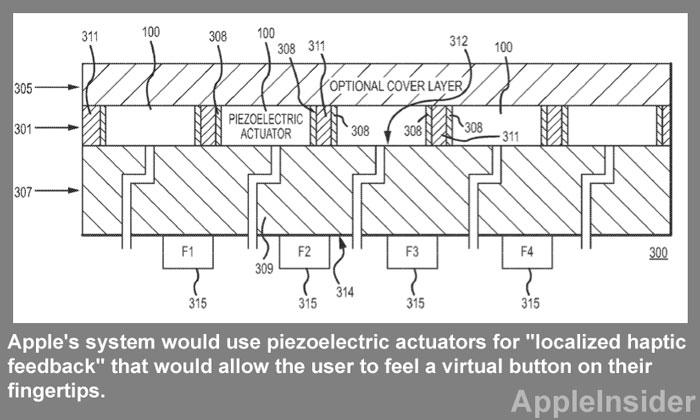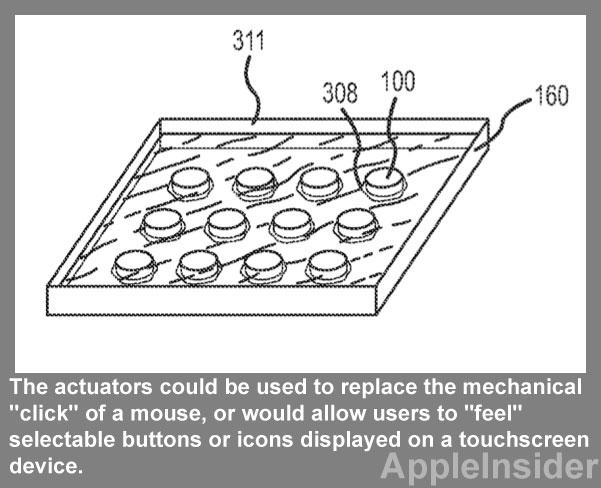Apple's haptic touch feedback concept uses actuators, senses force on iPhone, iPad
The concept was unveiled this week in a patent application discovered by AppleInsider entitled "Touch-Based User Interface with Haptic Feedback." The use of actuators underneath a touchscreen could allow users to actually feel elements on the screen, such as buttons or controls.
The timing of the application being made public by the U.S. Patent and Trademark Office is interesting because one rumor from earlier this month incorrectly suggested Apple would introduce new haptic feedback technology in its third-generation iPad. That rumor was based on technology from the company Senseg, which creates an electric field on the surface of a touchscreen, allowing users to feel complex, context-sensitive textures, such as making a surface feel smooth or rough to the touch.
The concept described in Apple's new patent application is quite different, relying on actuators to physically provide haptic feedback on a touchscreen, rather than giving sensations through an electric field. But it demonstrates Apple's continued pursuit of providing users with some sort of physical feedback when using a touchscreen device.
"The user can typically only feel the rigid surface of the touch screen, making it difficult to find icons, hyperlinks, textboxes, or other user-selectable elements that are being displayed," Apple's filing reads. "A touch-based user interface may help a user navigate content displayed on the display screen by incorporating haptic feedback."
Rather than simply vibrating the device when a button is tapped, as some touchscreen devices do, Apple's solution could utilize piezoelectric actuators for "localized haptic feedback." This would allow the user to feel a virtual button on their fingertips.
Specifically named as products that could benefit from haptic feedback in the application are the iPhone and iPad, as well as the Magic Mouse and Apple's notebook trackpads.
The application describes a touchscreen with a "haptic feedback layer" that could include piezoelectric actuators aligned in a grid pattern. These actuators could be located below an external protective layer that the user would touch to interact with the device, or the haptic layer itself could be the outermost layer.
The actuators could be used to replace the mechanical "click" of a mouse, or would allow users to "feel" selectable buttons or icons displayed on a touchscreen device.
Another element described in the application is the use of "force sensors" in a touchscreen device. With these, an iPhone or iPad could determine how much force a user is applying to the touch-based user interface, and respond to just how hard the user is tapping the screen.
To allow this, the outer screen of the device would "flex minimally," but enough that the force sensors would be able to detect any pushing or squeezing of the device by the user.
The application, made public this week, was first filed by Apple in September of 2010. The proposed invention is credited to Paul G. Puskarich and Michael Pilliod.
Apple's interest in adding haptic feedback to touchscreen devices is not new. In 2010, the company filed a patent application for what it called a "multi-haptic" system that would detect multi-touch gestures and provide a number of physical feedback responses accordingly.
And in 2009, before the iPad was announced, one application described a tablet-style device with a dynamic surface that would give users tactile feedback when typing in order to identify individual keys on their fingertips.
 Neil Hughes
Neil Hughes












 Andrew Orr
Andrew Orr
 Wesley Hilliard
Wesley Hilliard
 Amber Neely
Amber Neely

 William Gallagher
William Gallagher

 Malcolm Owen
Malcolm Owen







